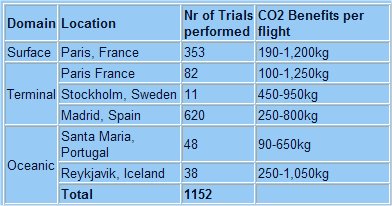400t of CO2 saved on AIRE flights

The SESAR Joint Undertaking (SJU) today presents at ATC Global in Amsterdam results from the European flight demonstrations performed in the framework of the Atlantic Interoperability Initiative to Reduce Emissions (AIRE), its green component.
 Summary of environmental benefits per flight (depending on aircraft type and baseline)
Greening of transatlantic flight
AIRE was launched in 2007, designed to improve energy efficiency and aircraft noise in cooperation with the Federal Aviation Administration (FAA). The SJU is responsible for its management from a European perspective. Under this initiative ATM stakeholders work collaboratively to perform integrated flight trials validating solutions for the reduction of CO2 emissions for surface, terminal and oceanic operations to substantially accelerate the pace of change.
The FAA worked with selected partners in North America and Europe to conduct trials in the oceanic and arrival domains in 2009. They completed 73 trials on oceanic optimisation and 68 trials to reduce arrival emissions into Miami.
Beginning of 2010, the SJU issued a call for tenders on the Performance of flight trials validating solutions for the reduction of CO2 emissions to expand the AIRE initiative. It is expected that the corresponding contracts will be signed by May 2010. The focus of the projects should be to implement quick wins or best practices.
Summary of environmental benefits per flight (depending on aircraft type and baseline)
Greening of transatlantic flight
AIRE was launched in 2007, designed to improve energy efficiency and aircraft noise in cooperation with the Federal Aviation Administration (FAA). The SJU is responsible for its management from a European perspective. Under this initiative ATM stakeholders work collaboratively to perform integrated flight trials validating solutions for the reduction of CO2 emissions for surface, terminal and oceanic operations to substantially accelerate the pace of change.
The FAA worked with selected partners in North America and Europe to conduct trials in the oceanic and arrival domains in 2009. They completed 73 trials on oceanic optimisation and 68 trials to reduce arrival emissions into Miami.
Beginning of 2010, the SJU issued a call for tenders on the Performance of flight trials validating solutions for the reduction of CO2 emissions to expand the AIRE initiative. It is expected that the corresponding contracts will be signed by May 2010. The focus of the projects should be to implement quick wins or best practices.
The project results show that by improving current procedures, considerable gains in terms of fuel efficiency and consequently lower CO2 emissions can be achieved. Additionally, green approach procedures already enable lower noise pollution and improve local air quality in and around airports.
AIRE was launched with a very simple and proactive approach: how can we work together in making aviation become greener? In 2008, the SJU published a call for tenders to co-finance the execution of green flight trials on the ground, in approach and climb areas as well as in the oceanic domain. As a result, six projects were initiated, taking place in Paris (ground movements, green arrivals and departures), Madrid and Stockholm (green approaches and climbs), Portugal and Iceland (oceanic flight optimisation).
While the main aim of the test campaign was to evaluate the applicability and effectiveness of green flight procedures, concrete fuel and CO2 savings could be measured. In total, 1,152 flights were performed in the framework of AIRE. Analysis of the data collected show that 400 tonnes of CO2 could be saved which corresponds to the annual CO2 emission of 100 passenger cars.
The AIRE activities performed in 2009 have shown encouraging results. It is now essential that we transform them from flight trials to day-to-day operations, in order to realise the full benefits of SESAR. The initiative has also proven that environmental benefits and economic reasoning are no contradictions, said Patrick Ky, Executive Director of the SESAR Joint Undertaking.
The 18 AIRE partners (ADACEL, AENA, Aéroports de Paris, Airbus, Air France, AVTECH, DSNA, Egis Avia, Iberia, Icelandair, INECO, Isavia, LFV, Nav Portugal, Novair, TAP Portugal, TERN Systems and Thales) conducted green surface, terminal and oceanic procedures. In 2009, green ground movement trials performed at Paris Charles De Gaulle airport demonstrated the effectiveness of a new collaborative decision support system which minimises taxi time and allows for reduced engine taxi operation. Green approach (such as Continuous Descent Approaches - CDA) or green climb trials at Madrid, Paris and Stockholm airports were conducted. The first Required Navigation Performance (RNP) based CDA approach ever to be performed in Europe was effected at Stockholms Arlanda airport. Trials for green oceanic procedures and techniques (speed, horizontal and lateral flight profile optimisation) on selected routes between Europe and North/Central America and the Caribbeans were carried out.
The results shown in AIRE are very promising. They represent not only substantial improvements for the greening of air transport but the motivation and positive commitment from the teams involved created momentum to continue and make progress on this important issue. The SESAR goal of 10% savings per flight are still far away, but the AIRE approach, exploiting the full potential of todays technologies, shows that we will get there. The value of working together with common goals is enormous. This is the partnership spirit in practice, Patrick Ky underlined.




.jpg)


.png)

Comments
There are no comments yet for this item
Join the discussion